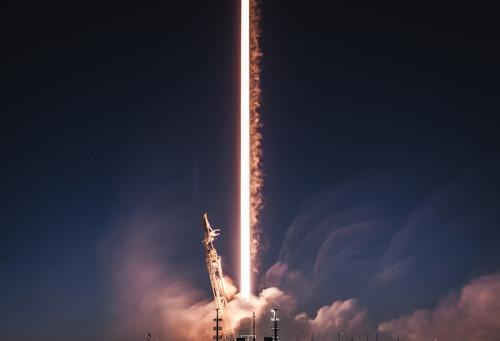Beijing, 10 Feb (Xinhua) -- As many as 40 of the 49 "Starlink" satellites launched by the company on the 3rd of february were destroyed the next day due to a geomagnetic storm. It is believed to be the largest damage a single geomagnetic storm has caused to a satellite.

Pictured on February 22, 2018, at Vandenberg Air Force Base in California, the "Falcon 9" rocket of the American private company Space Exploration Technology Company was launched. In addition to sending a Spanish satellite into orbit, the rocket also sent the first prototype satellites of the company's satellite Internet project into space in preparation for the construction of a "star chain". (Xinhua News Agency, courtesy of the United States Space Exploration Technology Corporation)
The rescue failed
The official website of the Space Exploration Technology Company released an update on the 8th that the company launched 49 "Starlink" satellites to an orbit lower than the predetermined orbit on the 3rd according to the convention, and prepared to make preliminary tests on these satellites and send them into a predetermined orbit 210 kilometers above the ground.
"Unfortunately," Space Exploration Technologies said, a magnetic storm that occurred on the 4th had a serious impact on these satellites, warming the atmosphere in the area where the satellites were located, increasing in density and increasing atmospheric resistance by up to 50% compared with previous levels of launch.
The StarLink team then controlled the satellite into safe flight mode, allowing the satellite to fly "sideways" to reduce atmospheric drag. However, most satellites have not been able to return to normal mode after entering safe mode, so "up to 40 satellites will re-enter or have re-entered the Earth's atmosphere"
Space Exploration Technologies says the risk of deorbited satellites colliding with other satellites is "zero" and will burn up when they re-enter the atmosphere, leaving no debris left in space or debris falling to the ground.
Ignoring warnings?
According to Reuters, before the launch of these "Starlink" satellites, the US Space Weather Forecast Center predicted the possibility of geomagnetic storms. The center previously warned that a strong solar flare activity was detected on January 29, and that the ejected material and energy could reach Earth as early as February 1, triggering a geomagnetic storm that could last until February 3.
Pictured on February 22, 2018, at Vandenberg Air Force Base in California, the "Falcon 9" rocket of the American private company Space Exploration Technology Company was launched. (Xinhua News Agency, courtesy of the United States Space Exploration Technology Corporation)
Flares are activities that suddenly brighten locally areas of the Sun's atmosphere, accompanied by the production of intensely enhanced electromagnetic radiation, solar proton events (large streams of high-energy charged particles), and coronal mass ejections. When the material and energy ejected by these activities reach near-Earth space, they will strongly disturb the Earth's magnetosphere, ionosphere and upper atmosphere, triggering geomagnetic storms.
Jonathan McDowell, an expert at the Harvard-Smithsonian Center for Astrophysics, believes that the damage caused by geomagnetic storms to satellites this time is the largest single-time damage, and it is also the first time that large-scale damage to satellites due to increased atmospheric density.
McDowell said it's unclear whether the increased atmospheric drag caused by geomagnetic storms exceeds the limits of satellite designs, or whether Space Exploration Technologies mistakenly believes that satellites can withstand such resistance. He said that from the statement of Space Exploration Technology, they did not anticipate that they would have to deal with such atmospheric resistance, "as if they did not pay attention to space weather forecasts."
CNN quoted Bill Merta, program coordinator at the Space Weather Forecast Center, as saying that people in charge of satellite launches usually pay close attention to space weather before launch, but different companies have different criteria for judging whether space weather will affect launches.
Space Exploration Technologies has yet to respond to media inquiries about the company's pre-launch assessment of space weather.
The loss is unknown
The economic damage caused by the incident is unclear. Space Exploration Technologies did not disclose the cost of the Starlink satellite. According to CNN, the company's president, Gwen Shortwell, said in 2019 that each satellite cost well under $1 million.
According to Reuters, the Starlink project previously planned to launch 12,000 low-altitude satellites into space between 2019 and 2024 to build a network to provide Internet services, and later increased the planned number of launches to about 30,000.
Space Exploration Technologies CEO Elon Musk said in a social media post on January 15 that the Starlink project has nearly 1,500 working satellites, and another 272 satellites are moving towards the intended orbit.
Starlink satellites undergo preliminary testing in a lower altitude orbit before reaching a predetermined orbit, and if they are exposed, they re-enter the Earth's atmosphere under the operation of ground controllers and burn up in the process to avoid interfering with other satellites. Space Exploration Technologies says it rarely happens for satellites to be exposed to problems at this stage, and that the step was arranged just in case. (Ou Sa)